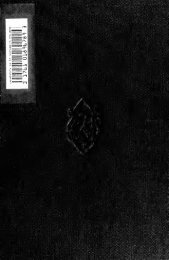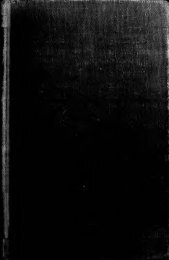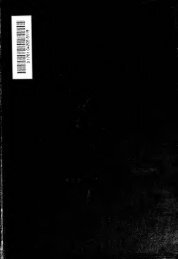Ecclesiastes - GA Barton - 1908.pdf
Ecclesiastes - GA Barton - 1908.pdf
Ecclesiastes - GA Barton - 1908.pdf
You also want an ePaper? Increase the reach of your titles
YUMPU automatically turns print PDFs into web optimized ePapers that Google loves.
26<br />
ECCLESIASTES<br />
leaves, 6 8<br />
~7 22 and 2C 9<br />
on the fifteenth and ; sixteenth, 4 ~5 8 on ; the seven-<br />
teenth, io 16-n 6 and 5<br />
; on the eighteenth, 7 23 -8 5a ; on the nineteenth (end<br />
of the third fascicle), io 2' 15 and i4 b ; on the twentieth, p 3 - 10 ; on the twenty-<br />
first and probably the twenty-second, n 7 -i2 8 .<br />
The string which held these fascicles together broke and the middle<br />
fascicle fell out. The leaves were found by some one not qualified to put<br />
them together, who took the inner half of the second fascicle, folded it<br />
inside out, and then laid it in the new order immediately after the first<br />
fascicle. Next came the inner sheet of the third fascicle, followed by<br />
the outside half of the second, into the middle of which the two double<br />
leaves, 13, 18, 14, 17 had already been inserted. Although the fourth<br />
fascicle kept its it place, did not escape confusion, for between its leaves<br />
the first two leaves of the remaining sheet of the third fascicle found a<br />
place. Finally, leaf 17, becoming separated from its new environment,<br />
found a resting place between 19 and 21. This dislocation removed<br />
from the work all traces of its plan.<br />
In the new form it frequently happened that some of the edges did<br />
not join properly a fact which led in time to the insertion of glosses.<br />
From this dislocated archetype all extant texts of Qoheleth have de-<br />
scended.<br />
If now the original order of the leaves be restored and the glosses re-<br />
moved, the work falls into two distinct halves, a speculative and a practical,<br />
each distinguished from the other by its own appropriate character-<br />
istics. According to Bickell this first half consisted of the following:<br />
Ch. i 1 -2 11<br />
5 9 -6 7<br />
3 9<br />
~4 8 2 12b - 18 - 26 - 12a - l3 - 17 3 1 - 8 86 - 14 - 16a - 17a - I6b - 17b o 1 - 3 815 Qii-is I0 i 6 8 - 10 -i 2 . In this part it is demonstrated that life is an<br />
empty round, and that wisdom only serves to make its possessor modest,<br />
so that he does not get on as well as the vainly boasting fool.<br />
Part two consisted of the following: Ch. 7 la lo 1<br />
11. 12. 21. 2J. 20. 49-17<br />
ct-8 IO 16-20<br />
j^l-3.<br />
jO 14a - 15 - 14b Q3-10 ij7-10a I2 la ijlOb I2 lb-6. 8_<br />
7 lb -6 6 9 7 -10 - 18 -19-<br />
7<br />
6. 4. 5 *23-29 gl-4 JQ2-13 n!5 f(g\<br />
In this part the advice of Qoheleth is, in view of the fact that life offers<br />
no positive good, to make the best of such advantages as we have, to<br />
live modestly before the ruler and before God, and to expect everything<br />
to be vanity.<br />
The epilogue Bickell thought was from a later hand. This<br />
elaborate theory, rejected by most scholars, as too ingenious and<br />
improbable, has been accepted in full by Dillon, who sought in his<br />
Skeptics of the Old Testament, 1895, to commend it to English<br />
readers. The theory is not only intricate and elaborate to a de-<br />
a modern scholar<br />
gree which creates doubts that, if it were true,<br />
would ever have divined it, but it breaks down archaeologically<br />
in





